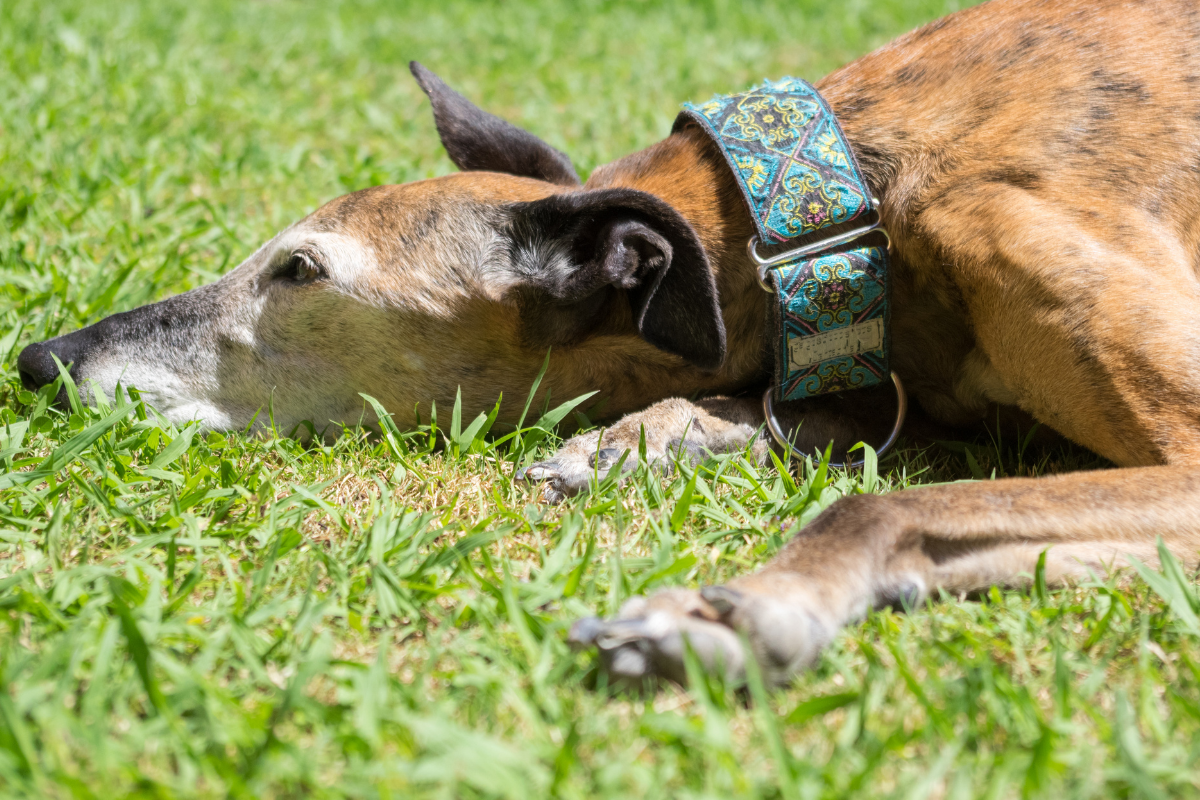
Summer Safety Tips for a Happy Healthy Hound
Dr Erin Dowler BVSc
As the days are growing longer, hounds and hoomans alike are holding out for those summer months where NZ really shines! Tootsies are no longer traumatised by the touch of wet grass, embarrassing PJs are folded away and there are new smells for snoots to sniff.
While it is a special time of year, we need to ensure the furry members of our family are safe too, so the season can be enjoyed by all.
Check the temperature of the ground.
Your hands are less sensitive than your feet, so kick off your jandals and test barefoot. If you can’t comfortably stand long enough to wait for a pedestrian light to change, neither can they and the ground is too hot! Be particularly mindful of sand, as this is often much hotter than the concrete and can heat up more quickly, so you may need to do repeat checks and make sure you’re off the beach before the day heats up.
Walk your hound during cool times of the day.
Think of your hound’s coat like wearing a full-length fur jacket, so if you wouldn’t be comfortable out in one, neither are they! Unlike us, dogs only have sweat glands on their paws, so it’s much more difficult for them to cool down, leaving their only option to pant. This makes them much more susceptible to heat stroke. Walk your hound early or late in the day for a safe enjoyable walk for them – and probably you too!
Take a drink bottle for your dog.
Just like us, hounds need to be able to keep hydrated when they exercise. There are some great portable bowls out there if your hound hasn’t gotten the knack of drinking from the bottle. This also avoids your hound having to drink from shared water bowls (which are rudely not elevated), helping reduce the chance of infectious canine cough. Additionally, if the day is warming up on your return journey, you have the option of cooling your hound with a (highly offensive) spritzing.
Invest in a cool environment for your hound.
Make sure that when they are outside, they have access to shade, ideally with a comfy bed beneath it of course. They appreciate fans and air conditioning as much as we do, and cooling mats may provide additional comfort.
Get creative with some cool treats.
Any dog-safe tasty liquid, such as pet milk and broth, can be turned into a delicious icy treat. We love ice blocks in summer, so why wouldn’t they! You can also freeze some of their favourite treats inside a Kong and keep them entertained with some great environmental enrichment.
Never leave your dog in your parked car over summer.
Every year, tragedy strikes after the thought “I’ll only be a second”. Don’t risk it. Even in the shade. Even with the windows open. The risk of living with the consequences of losing a beloved pet through a small miscalculation is simply too great.
Monitor the barbeque.
Counter surfing snoots are particularly interested in the sizzling sound and smell of steak and sausages, but a burnt nose is no fun for anyone! You wouldn’t believe what they will swallow and skewers that smell like meat have disappeared inside many dogs, so make sure that they are immediately disposed of safely or put out of reach for cleaning to avoid a disastrous day for everyone.
Keep the Christmas ham all to yourself.
When those big eyes are staring up at you begging, resist! Eating ham and other high fat foods can cause gastroenteritis and even pancreatitis, with marked abdominal pain to accompany the unpleasant evacuations from both ends. Let’s keep you and your hound out of the emergency vets this silly season! Perhaps you could spare some skinless roast chicken instead.
Check between toes and armpits for grass seeds after walks.
Grass seeds (especially from barley grass) are very sticky and lodge themselves wherever they can. The awns have a very sharp tip, so if not found and removed promptly, they can burrow deep into the skin. Due to their shape, they act like a fishhook and once they are in, they are hard to get out! If you notice a red oozing blister-like lump on your dog (which they are usually licking), be sure to get it checked by your vet. Once the seeds have embedded, they migrate via the path of least resistance through the body, so trying to find them days or weeks on is the sort of treasure hunt you and your hound want to avoid.
Look out for karaka berries.
When the green berries turn orange, they start to drop off the trees and they are highly toxic to dogs. Ingestion can be fatal and there have been cases where simply licking a berry has resulted in severe toxicity. Once you start to look for them, there are lots in places where dogs also love to be. If you are worried your dog has picked one up, seek immediate veterinary care.
Keep your eyes peeled.
With more people enjoying the great outdoors, there unfortunately may be rubbish left behind, posing a risk to hounds with sensitive snoots and fast moving teefies. Cooked bones can cause broken teeth, intestinal obstructions, perforations or constipation. It’s worth training your hound a “drop” command at home so that you have it available in a real-world situation when you need it. Ingestion isn’t the only issue - a small piece of glass can enter the paw pad and be the start of a corn, causing ongoing pain.
Don’t spray and walk away.
Wet and forget is not safe for pets until it is completely dry. If contacted when still wet, the product will burn the paws and if they try to lick their pads clean, can also result in burns and ulcerations in and around the mouth. It’s critical that pets don’t have access to recently sprayed areas.
Keep toxic treats out of reach.
Christmas pudding, dark chocolate and a handful of sweet juicy grapes may be heaven to us but could be deadly for your dog. Grape (and therefore also raisin) ingestion can result in severe acute kidney disease and chocolate toxicity, due to theobromine, can result in gastrointestinal signs, seizures and sometimes death. If your dog has eaten either, seek immediate veterinary care. Your vet clinic will be able to work out if the amount of chocolate is concerning and when it comes to grapes/raisins, there is no “safe amount”. If vomiting is induced and activated charcoal is provided before a significant amount is absorbed into the bloodstream, it gives them the best chance, but little can be done once it is absorbed, so time is of the essence.
Be aware of the hidden deadly dangers.
In summer, the high temperatures and long dry periods allows overgrowth of cyanobacteria, in what is called algal blooms, throughout rivers in NZ. The blooms contain a severe neurotoxin and even a very small ingestion can be fatal. Some of NZ’s beautiful beaches have had puffer fish wash up, which harm dogs just as they do people. And perhaps some of the saddest sudden deaths have come from dogs simply licking toxic sea slugs. Make sure you research what to look out for locally and keep an eye on any new alerts in your area.
Use the extra daylight hours to beat the bad breath.
Given this is the most common disease in greyhounds, it’s something we should talk about every season. Greyhounds are genetically predisposed to periodontal disease, with less antibacterial components in their saliva, an increased immune response to plaque/tartar and a thin jaw relative to big teeth, meaning any bone loss through dental disease is more significant. When you are smelling your dog’s bad breath while they are lovingly breathing in your face, take the cue from the universe that it’s time to invest some of the extra daylight hours in learning to brush those teefies. While there a range of passive dental care products out there, these should ideally be used in combination with active dental care aka brushing every day. Preventative dental care not only prevents pain for your hound and helps keep the cost of vet dentistry down, but has been proven to improve their lifespan…and we all want as long as possible with our precious pets.
